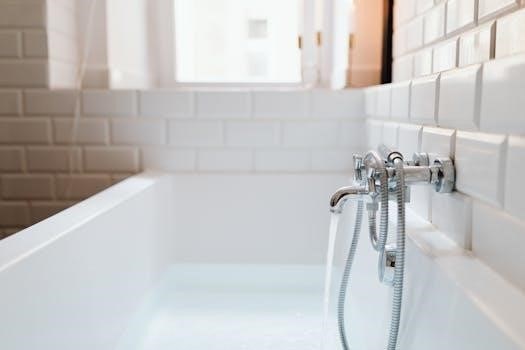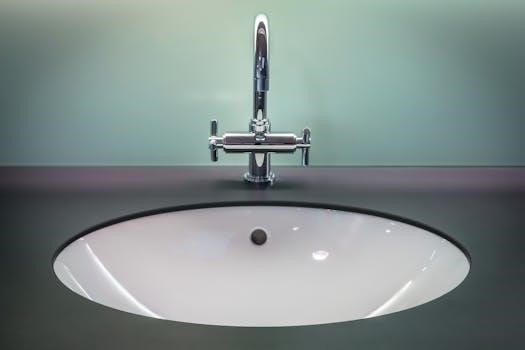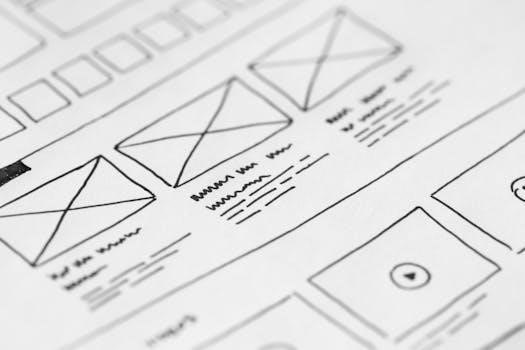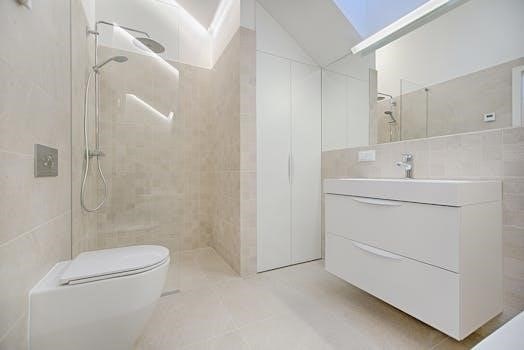Understanding the Importance of Plumbing in Bathroom Design
Plumbing is crucial in bathroom design, significantly impacting layout and usability. The placement of stacks and fixtures dictates the overall functionality and convenience of the space. Proper planning ensures a comfortable and efficient design.
How Plumbing Influences Bathroom Layout
Plumbing profoundly dictates the bathroom layout, primarily through existing water lines and drain stacks. Wet walls, thicker interior walls housing these lines, often determine fixture placement. Minimizing long horizontal runs of drain and vent pipes is crucial, encouraging fixture installation near wet walls. The configuration of these elements significantly impacts the functionality and flow of your bathroom space, thus requiring careful planning and consideration.

Initial Planning and Existing Plumbing
Before starting a bathroom renovation, understanding the current plumbing is essential. Existing lines and electrical wiring greatly influence the potential new layout and design.
Assessing Current Plumbing Lines
A critical first step involves thoroughly assessing the existing plumbing lines. This includes identifying the location of water supply pipes and drain lines. Understanding the current setup helps determine what changes are feasible and if any modifications are required. It also dictates the limitations and potential of your bathroom design, allowing for a realistic plan before any work begins. Ignoring this step could cause issues later.
Locating Wet Walls and Minimizing Horizontal Runs
Identifying wet walls, which house water lines, is crucial. Placing fixtures near these walls minimizes long horizontal runs of drain and vent pipes, simplifying plumbing. This approach reduces the risk of clogs and improves overall system efficiency. Keeping plumbing runs short and direct contributes to a more cost-effective and reliable installation. Proper planning in this stage is essential for long-term plumbing performance.

Bathroom Fixture Placement
Careful consideration should be given to the placement of the toilet, sink, shower, and tub. Optimal placement ensures comfort, convenience, and efficient use of the bathroom space.
Optimal Placement of Toilet, Sink, Shower, and Tub
When planning a bathroom, the position of each fixture is critical. Place the toilet near the main stack to minimize long horizontal drain runs. The sink should be conveniently located, often near the entrance or vanity. Consider shower and tub placement for efficient water supply and drainage, and ensure adequate space for comfortable use. These choices significantly impact the functionality and flow of the bathroom.
Considering Popular Bathroom Floor Plans
Exploring popular bathroom floor plans is essential for efficient plumbing design. Common layouts often feature fixtures along a shared ‘wet wall’ to minimize plumbing runs. A single sink and shower plan is ideal for guest bathrooms, while larger spaces can accommodate double sinks and separate showers and tubs. Choosing a floor plan that aligns with your needs and plumbing capabilities ensures a functional and aesthetically pleasing result.

Plumbing Rough-In Process
The plumbing rough-in involves running water supply and drain lines through framing. Accurate measurements and diagrams are critical for fixture placement and proper connections during this phase.
Running Water Supply and Drain Lines
During the rough-in stage, water supply lines and drain lines are installed through bored holes in wall studs and framing members. This involves carefully planning the path of pipes, ensuring they reach the intended fixture locations. Proper installation of these lines is essential for the functionality of the bathroom, and they must be securely fitted to avoid leaks and other issues. Attention to detail is critical.
Measurements and Diagrams for Fixture Placement
Accurate measurements and diagrams are crucial during the rough-in process. These detailed plans guide the precise placement of each fixture, including the toilet, sink, shower, and tub. The diagrams should clearly indicate the locations of supply and drain lines, ensuring everything aligns perfectly. This step is essential for preventing costly errors and guaranteeing a functional and comfortable bathroom.
Bathroom Plumbing Diagrams and Resources
Online bathroom planners offer tools to design layouts. Free plumbing diagrams can be found online. These resources aid in visualizing and planning your bathroom’s plumbing system effectively.
Finding Online Bathroom Planners
Utilize online bathroom planners to easily design your space, entering specific dimensions to begin building your dream layout. These tools allow you to visualize how plumbing products will fit within your bathroom, streamlining the renovation process. These planners help to ensure functionality and efficiency before any physical work begins, making the design phase much more manageable for homeowners.
Utilizing Free Plumbing Diagrams
Free plumbing diagrams are valuable resources for planning your bathroom layout. These diagrams often detail typical setups, showing connections for showers, sinks, and toilets. Such resources can help you understand how plumbing works. By using free diagrams, you can make informed decisions about your bathroom’s layout, ensuring a functional and efficient design while saving on initial planning costs.
Minimum Code Requirements and Clearances
Adhering to minimum distance codes is essential for safety and functionality. Proper clearances around fixtures ensure comfortable use, and compliance with codes is non-negotiable during bathroom renovations.
Adhering to Minimum Distance Codes
Minimum distance codes are crucial for bathroom safety and functionality. For example, a toilet requires a minimum of 30 inches of clearance from the side wall, though more is preferred. These codes are not suggestions, but rather requirements that must be followed during any bathroom renovation. Ensuring compliance guarantees a safe and usable space for all.
Ensuring Proper Clearance Around Fixtures
Proper clearance around bathroom fixtures is essential for comfortable use and accessibility. This includes adequate space around the toilet, sink, shower, and tub. Sufficient clearance prevents overcrowding and allows for easy movement within the bathroom. It also ensures compliance with building codes and enhances the overall safety and usability of the space, so it must be carefully considered.

Ventilation Considerations
Moving drain lines may require adjustments to ventilation systems. Proper ventilation is crucial to prevent moisture buildup and mold growth after making changes to the plumbing.
Addressing Ventilation Needs After Moving Drains
When altering your bathroom’s plumbing, especially by relocating drain lines, it’s essential to re-evaluate your ventilation. Moving drains can impact airflow, potentially leading to moisture and mold issues. Ensure proper ventilation by considering installing or adjusting exhaust fans. This helps maintain air quality and prevents problems associated with humidity buildup. Consult a professional if necessary to ensure adequate ventilation for your remodeled bathroom.
High-Quality Fixture Recommendations
When renovating, explore options for buying high-quality bathroom fixtures. Consider online retailers and local plumbing stores in your area for reliable products. Invest in durable, well-made items.
Exploring Options for Buying Bathroom Fixtures
When seeking high-quality bathroom fixtures, consider both online retailers and local plumbing stores. Look for durable and reliable products that suit your style and budget. Research different brands and materials to ensure you’re making informed decisions. Consider online options for more variety, or visit local stores to see products firsthand. Prioritize quality to avoid future issues.
Advanced Options and Layout Considerations
Larger bathrooms allow for luxurious features like whirlpools, freestanding tubs, walk-in showers, and double basins. These options enhance both functionality and aesthetic appeal, creating a spa-like experience.
Options for Large Bathrooms
When designing a large bathroom, numerous possibilities arise, allowing homeowners to create a truly customized space. Consider incorporating a luxurious whirlpool or a freestanding bathtub as a focal point. A separate walk-in shower can also add a sense of spaciousness. Furthermore, double basins offer added convenience and functionality for shared use, providing a personalized and comfortable experience.
Whirlpool, Freestanding Bath, Walk-in Shower and Double Basins
These luxurious additions greatly enhance a spacious bathroom. A whirlpool provides therapeutic relaxation, while a freestanding bath serves as a stylish centerpiece. A separate walk-in shower offers convenience and modern appeal. Double basins are perfect for couples, adding functionality and reducing morning congestion. These elements combined create a comfortable and spa-like environment within the home.
Common Plumbing Issues
Common plumbing problems include unblocking drains, repairing leaks, and addressing burst pipes. These issues require prompt attention to prevent further damage and ensure proper functionality in the bathroom.
Unblocking Drains and Repairing Leaks
Dealing with clogged drains and leaks are common bathroom plumbing challenges. Unblocking drains often involves removing obstructions or using drain cleaners. Repairing leaks quickly is crucial to prevent water damage and potential mold growth. Addressing these issues promptly maintains the bathroom’s functionality and prevents costly repairs down the line. Regular maintenance helps to mitigate these problems.
Addressing Burst Pipes and other Common Problems
Burst pipes are a serious plumbing emergency requiring immediate action to minimize damage. Other common problems include leaky faucets, running toilets, and low water pressure. Addressing these issues promptly prevents more significant damage and ensures the plumbing system’s efficiency. Professional plumbers can offer solutions and preventative measures for these problems. Regular maintenance can help avoid such situations.
